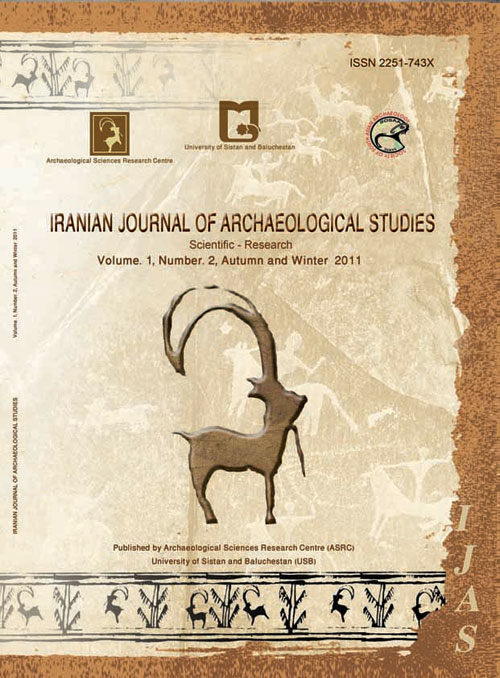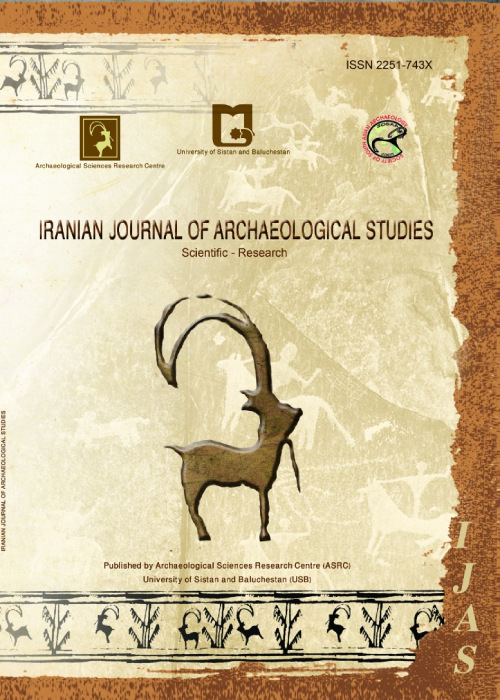فهرست مطالب

Iranian Journal of Archaeological Studies
Volume:10 Issue: 1, Winter and Spring 2020
- تاریخ انتشار: 1400/12/21
- تعداد عناوین: 6
-
-
Pages 1-16
Seleucus II Callinicus was the first Seleucid king (from 246 to 225 BC) who portrayed himself on coins bearded and wearing a diadem. This seems to be due to the wars that were waged in the Seleucid Empire during the reign of this king, including the separation of Parthia and Bactria from the Seleucid Empire, and the invasion of Arsaces. Seleucus II Callinicus embarked on an unsuccessful campaign against the Parni, and after this event he issued coins showing himself with a beard. In fact, such imagery presented the king both as a worshiper who had made vows to the gods - Apollo and Artemis - for his victory, and as a military commander. What is more, it cannot be ruled out that Seleucus also consciously referred to the iconography of the Achaemenid kings, who were always depicted with a beard, thus showing himself to his subjects as the legitimate king of Iran.
Keywords: Seleucid, Coinage, iconography of power, Royal, king, Beard, ideology -
Pages 17-29
Since many centuries ago, the art of tiling in Iran has been one of the most remarkable and plausible arts. The tile art-work is related to the subject of architecture, and beside its decorative aspect, it maintains the building endurance against humidity. Qajar period tiling was mainly used on the works of palaces, mosques, sacred shrines, religious schools and houses. Even in this period, it can be said that vase designs emphasizing naturalistic elements were more used, such as fruits, flowers, animals and birds were the main composition. In fact, the quality of art-work in Qajar’s period is not comparable with such of Safavid dynasty, but still it is considered as one of the brilliant art of this land. According to the deserted researches in Qajar’s period, particularly in tile-designing of Shiraz, this article tries to evaluate and introduce the tiling art of this period. Among many instances of tile art-work in houses of Qajar and Pahlavi, we opted for “Khaneh Atroush” or old residence of Hajj Mohammad Ali Firozabadi because of its fascinating tile art-work. Although the date of tiling of house referred to 1894, but it is considerable in style of Qajar’s painting.
Keywords: Art of Tiling, Qajar art, Khaneh Atroush, Shiraz, Iran -
Pages 31-46
Some production techniques of prehistoric ceramics are still continuing in the South and Southeast of Iran. One of these production techniques is common in the traditional workshops in the Shahvar and Hakami – Minab - for produc-ing “Jahleh” as a thin-walled ceramic. We can compare Jahleh with prehistoric wares. The question is, how do the ethno-archaeological studies on Jahleh, help us to understand the production techniques of the prehistoric ceramics? The research method includes interviews with potters in Shahvar and Hakami in 2019, the survey in some prehistoric sites, and the studies on prehistoric thin-walled ceramics. The analysis was done using analogy, and deductive rea-soning. Results show similarities between Jahleh and some of the prehistoric wares in Iran and Mesopotamia. If we pay attention to the “similarity between the tools”, “the pottery methods in Shahvar and Hakami”, and “some of the archaeological findings”, we can accept that the production method of prehis-toric thin-walled ceramics is similar to the method of producing Jahleh. There-fore, the study on the Jahleh in a contemporary context helps us to understand the processes of producing prehistoric ceramics.
Keywords: Ethno-archaeology, Shahvar, Hakami Villages, Minab, Jahleh ceramics, Prehistoric ceramics -
Pages 47-62
Sense of place is the factor that transforms a space into a place with special sensory and behavioural characteristicsfor individuals. Place is a sensible and perceptible space associated with memory, of which part of meaning can betraced in human experience and emotions. The key questions addressed in this article are how human beings feelthe environment through form structures, and what physical components and formal factors affect human beings’perception of a place. Finding replies to these questions requires understanding the factors and physical componentscausing sense of place and the effects of such factors and components both on creating sense of place and on oneanother. The purpose of this paper was to evaluate the effects and roles of architectural forms and structures of anenvironment on creating positive and negative emotions toward a place. To this end, we mention the meanings of suchconcepts as place, sense of place, and physical components being effective in creating sense of place, followed by anelaboration of different types of factors and components as well as their effects on creating sense of place. The datarequired for this study was collected using a descriptive-analytical research method combined with a case study onHafez Garden-Tomb in the north of Shiraz and in the south of the gates of the Quran. The results indicated that boththe physical environment and forms play important roles in creating sense of place through specific mechanisms. Inaddition, the findings of the case study showed that the structural form of Hafez Garden-Tomb consists of componentshaving effects not only on the sense associated with the place but also on other factors creating sense of place.
Keywords: sense of place, Form, physical components, Hafez Garden-Tomb -
Pages 63-74
Southern Zagros mountainous region which is the country (Yelagh as local name) for Bakhtiari and a few of Qashqayi tribes, is resided during spring and summer due to suitable geographical and climate conditions such as sufficient water supplies, acceptable pastures and timing for the growth of plants. The mentioned tribes spend their winter quarters during fall and winter in some regions in the Khuzestan and the Fars provinces. In the country regions, the immigrants choose specific places to reside and camp depending on the climate conditions, the level of security for the people and the herd, protection from wind and raining, access to water supplies, and growth of plants in the pastures. This study aims to identify the ancient ways of choosing the locations for camping in the country regions and show where campsites can be easily located. This will be achieved through the Middle Range Theory (MRT) by studying and evaluating modern pastoral groups.
Keywords: Southern Zagros, Bakhtiari, country, winter quarters, campsite, Middle Range Theory -
Pages 75-93
During the Holocene, man’s challenges with climate entered a new phase. Holocene climatic cycles, by creating dry events, have imposed many subsistence tensions on water-dependent communities. The semi-arid and arid region of North Central Iran, which has been very vulnerable to any climate change, experienced unfavorable environmental conditions during these climatic events. So far, only a handful of Early Holocene rural settlements have been found in the region, possibly because of the mostly arid climate of the period. In general, the first evidence of Neolithic villages in North Central Iran dates back to the beginning of the Middle Holocene, after the 8.2 ka BP event. The first cultural flourishing of this region can be seen from the last quarter of the sixth millennium BCE. Each cultural flourishing period seems to have declined for some time with the occurrence of a dry event. The effects of climatic tensions on human societies in North Central Iran have been found around 6500-6000, 5700-5400, 5000-4700, 4300-4000, and 3300-2700 BCE. According to data analysis, the frequency of settlements and the trend of cultural progress gradually peaked from the early sixth millennium to the mid-fourth millennium BC, but in the second half of the latter millennium, a gradual decline began which led to the Bronze Age collapse in ca. 2700 BCE. This event probably occurred due to the drop in temperature and the increase in the frequency and severity of aridity in the transition phase to the Late Holocene.
Keywords: Paleoclimate, Middle Holocene, Dry event, North Central Iran, Cultural evolution


